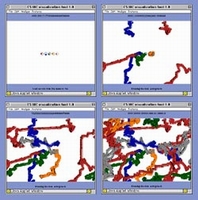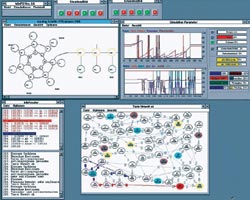| ::: txt | ::: love | ::: xls | ::: user |
mailto: travellab_associates
travellab.love
::: psi system


The mapping of the performance of activities and their related channels within the system are regarded as the result of an organization of actions and decision making processes; both will be presented in a model of an organization of actions and decision making. This model is available in realm of the PSI-Theory. The model serves to produce a so-called plan - i.e. an intended process of the performance of activities and channels - which forms the basis for the further dramaturgical development.
The PSI-Model represents an architecture, a basic model of human mental functions. However, the approach explicitly goes beyond the mere cognitive capacities and directly integrates perception, body movements, actions, emotions and motivation. PSI does not represent an architecture of a production system, it is more a holistic system that combines both, symbolic and sub-symbolic approaches. Within the model, emotions, consciousness and perception are described as a system for information processing. Core concept is the intention that connects knowledge, acting and motivation.
PSI has a memory that consists of sensory and motor "schemata". Sensory schemata represent the agent´s knowledge of his environment; motor schemata are behaviour programs, but PSI does not make a distinction between different forms of memory. In PSI, intentions control the action. These intentions are defined - on an operational level - as a combination of the selected motive and the information connected with the active motivator within the mnemonic network. This information affects the targets which are aimed at, the operators or schemata of action, the knowledge of the previous, unsuccessful approaches for solving the problem as well as the concepts and plans that PSI produces by means of heuristic procedures. All this information consists of neuronal networks; the working memory of PSI represents an intention as an aggregate of all this information.
In PSI, the motivators for certainty and competence - i.e. two informational needs - form the vital mechanisms for emotional regulation. Active motivators of certainty and competence trigger off specific actions or increase the disposition to do so: "A decline in certainty leads to an increase of background control". That means that PSI - more often than usual - turns away from its current intention and controls the environment. Because everything is possible if you are not able to pre- calculate the environment. (...) Moreover, a falling degree of certainty results either in a higher tendency to flight behaviour or in behaviour patterns of specific exploration. (...)
The refusal of giving information is regarded as less extreme cases of flight behaviour; the fields of reality which have been proven uncertain are simply disregarded; this "withdrawal" from reality is also connected with the fact that PSI - at a falling degree of certainty - becomes more hesitant as far as its behaviour is concerned; it does not take actions as fast as usual, its planning time is longer than in other circumstances and it is not that "courageous" when it comes to exploration.
Therefore, in PSI, emotions do not emerge in an own emotional module but as a consequence of control processes inherent in a homeostatic system. Schaub puts it as follows:
"We define human emotions as the way of how actions are organized, in association with the respective motivations" (Schaub, 1995, page 6)
Dörner acknowledges that in the PSI-System, a variety of emotions cannot be shown yet due to the fact that a module for self-observation and self-reflexion is still missing. This, though, would only be a question of a refined implementation of the model and therefore does not constitute a real problem.
PSI does not follow any explicit rules, but forms a kind of connectionistic system that produces emotions by self-organization.